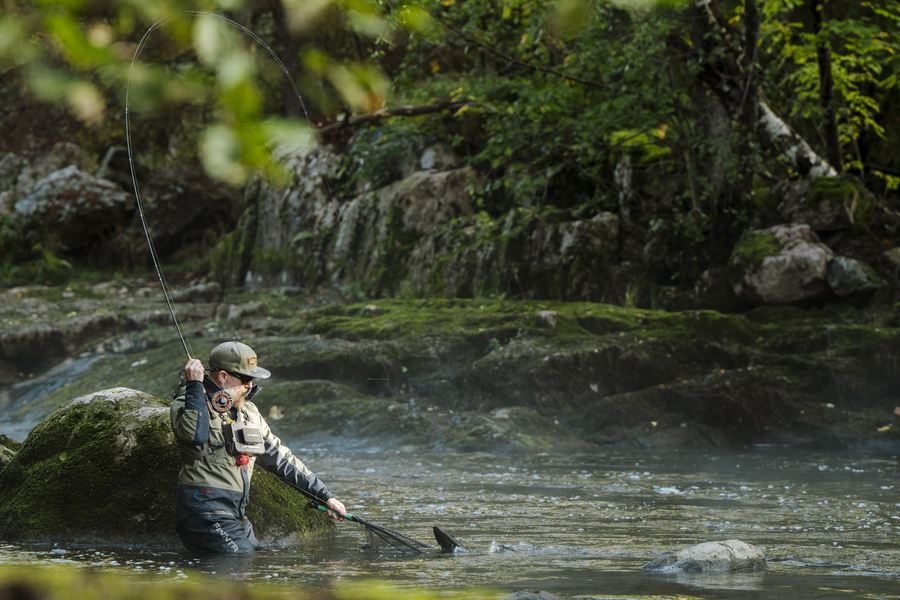How to Wear Waders with Wade Jacket Properly
Wearing waders and a wading jacket is essential for fly fishing, whether you're casting flies in a narrow mountain stream, wading into a cold river, or standing along the bank of a still lake. The right gear doesn't just keep you dry — it keeps you comfortable, safe, and agile. However, many anglers — especially those new to the sport — often wonder how to best layer their clothing and gear to handle a variety of conditions.
This guide will walk you through the key considerations for wearing waders and a wading jacket together, helping you stay dry, warm, and mobile no matter the weather or water conditions. From base layers to jacket placement and environmental factors, we’ll cover everything you need to know to maximize comfort and functionality on the water.

Understanding What to Wear Under Waders
The first step in choosing the right attire for waders is knowing what to wear underneath. The right base layers are key to maintaining comfort during long hours of fishing. The first material to avoid is cotton. Cotton retains moisture and can lead to discomfort, chafing, and even hypothermia in cold conditions. Instead, opt for moisture-wicking materials like merino wool or synthetic fabrics such as polyester and fleece.
Base Layers for Cold Weather
For colder temperatures, merino wool or synthetic fabrics like fleece and polyester blends are ideal. Merino wool, in particular, offers excellent thermal insulation, keeps you warm even when damp, and is naturally resistant to odors — making it perfect for multi-day fishing trips. Fleece is another strong contender, offering a great balance of warmth, breathability, and moisture management.
Pair your top with insulated or thermal base layer pants, or opt for fleece-lined leggings for especially cold days. These layers provide a soft buffer between your skin and the wader material, improving comfort while enhancing insulation.
Base Layers for Warm Weather
When fishing in the warmer months or in mild climates, your approach should shift to prioritizing breathability and quick-drying fabrics. Lightweight synthetic shirts, athletic tights, or even gym shorts can work under breathable waders. For anglers who prefer wet wading you might only need quick-drying shorts and wading boots.
Always match your base layers to the expected temperature range and level of physical activity. If you're hiking long distances along a river, for instance, you'll need layers that breathe well and wick away sweat.
Deciding Between Jacket Inside or Outside Waders
Once you’ve got the right base layers, the next question is how to wear your wading jacket: inside or outside the waders? While some anglers debate the pros and cons of each, the most recommended approach is to wear the jacket outside your waders.
Why the Outside is Better
Wearing your wading jacket on the outside creates a more effective weather barrier, helping to shed rain, block wind, and deflect water splashes. Most modern wading jackets are specifically designed with this in mind, featuring:
-
High-cut hems that sit above the wader belt line
-
Adjustable cuffs to seal out water at the wrists
-
Storm flaps and waterproof zippers for additional protection
-
Multiple utility pockets for quick access to gear like fly boxes, leaders, floatant, and tools
This external configuration keeps your jacket functioning as an outer shell — its intended purpose — and allows for easier layering and gear access throughout the day. Although some worry that wearing a jacket outside might allow water in during a fall, a properly fitted wading belt and high-performance outerwear reduce this risk.
Adapting to Different Weather Conditions
Your layering and jacket setup should change based on the season, temperature, and water conditions.
Spring and Summer Fishing
In the warmer months, many anglers skip the wading jacket entirely unless there's rain in the forecast. Lightweight, breathable waders with a simple base layer (like a moisture-wicking t-shirt and quick-dry pants) are usually sufficient. If rain is likely, a packable rain shell can double as a wading jacket without adding much weight to your gear.
Fall and Winter Fishing
Colder weather demands a more strategic approach. In addition to your base layers, you might wear an insulated mid-layer (like a synthetic puffy jacket or fleece pullover) beneath your wading jacket. Your wading jacket should have enough room to fit over these layers without restricting movement. If your jacket feels tight or short with layers underneath, consider upgrading to one designed for cold-weather fishing.
During freezing temperatures, make sure you also pay attention to accessories:
-
Wool or synthetic gloves (fingerless or convertible for tying knots)
-
Thermal beanies or caps
-
Neck gaiters or buffs to protect against wind and splash
Bonus Tips for Maximum Comfort and Safety
-
Use breathable waders whenever possible to reduce sweat and condensation buildup inside your gear.
-
Dry your gear thoroughly after each trip to prevent mildew and prolong lifespan.
-
Invest in gravel guards or use integrated ones to prevent debris from entering your boots.
-
Don’t skip the wading belt—it’s a crucial safety tool that prevents waders from filling rapidly with water in case of a fall.
Conclusion
Wearing waders with a wading jacket properly is about finding the right combination of base layers, jacket positioning, and overall fit to ensure comfort and protection against the elements. By wearing your jacket over your waders, you gain better protection from rain and splashes, while also keeping important gear within easy reach. This setup also aligns with how most modern wading jackets are designed — to shed water and seal out the elements from the outside.
By following these guidelines, you can make sure that your wading jacket and waders are properly layered, allowing you to focus on what really matters — landing that perfect catch.





